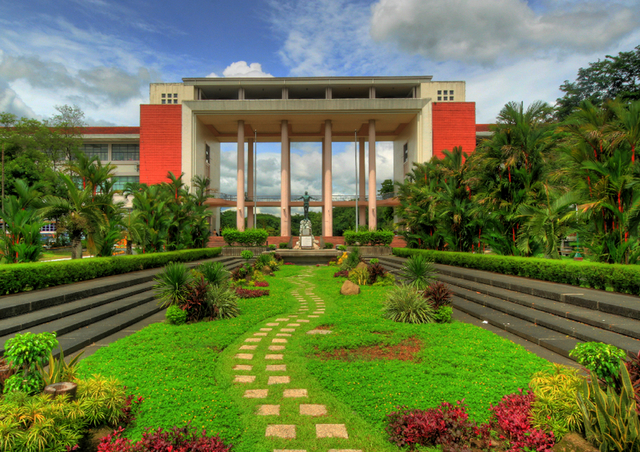Trivia about the University of the Philippines
 The University of the Philippines (UP) is the country’s premier university. It was established in 1908 by the American colonial government to provide quality education in philosophy, the sciences and the arts, as well as professional and technical training, to deserving students of all classes.
The University of the Philippines (UP) is the country’s premier university. It was established in 1908 by the American colonial government to provide quality education in philosophy, the sciences and the arts, as well as professional and technical training, to deserving students of all classes.
From a small campus in old Manila, with only 7 colleges, it has grown into a university system, with seven constituent universities located in 12 campuses throughout the Philippine archipelago and in cyberspace: UP Diliman, the flagship campus; UP Manila, UP Los Banos; UP Visayas; UP Mindanao; UP Baguio and the UP Open University. The president is elected by a Board of Regents. This Board is the highest policy-making body. Each constituent university is headed by a chancellor.
UP Diliman is a comprehensive university, excelling in the arts, the natural sciences, the social sciences, and the different professional programs such as architecture, engineering, business administration, mass communications, and law. UP Manila is the country’s leading institute in medicine and other health professions. UP Los Banos leads in agriculture, forestry, and environmental education and research. UP Visayas’ particular area of expertise is fisheries and marine biology. The UP Open University is the country’s pioneering institution in distance education and open learning. UP Mindanao hopes to become a center of culture and languages, as well as the best science university, in the south. And UP Baguio, the youngest campus, is now the leading tertiary level institution in the north in the areas of science, mathematics, social sciences, and humanities.
There are 3,600 regular faculty members in the System, and the University grants degrees to about 7,700 graduates each year. It offers 258 undergraduate and 438 graduate programs. No other academic institute in the country can match the scope and range of the University’s course offerings, which include almost all disciplines and embrace all interests and inclinations. And its student population of over SO,OOO thrives in the liberal atmosphere that is an integral part of the tradition of a UP education.
Over the years, UP has built a solid reputation as a research and graduate university producing both scientific and artistic outputs which receive national and international recognition.
To date, the University has produced 30 out of 31 National Scientists in fields as diverse as history, engineering, physics, agriculture, biophysical chemistry, psychology, medicine, plant physiology, genetics, and cytogenetics. In the age of technological breakthroughs, UP is at the forefront of exploring “emerging fields” in Science and Technology. The overarching goal is to identify high-priority, cutting-edge areas where the University can make a difference, such as Materials Biotechnology or Bioengineering, Pervasive Computing, and Measurement Instrumentation. The University’s scientists are expected to break new ground in bio-fuels, pharmaceuticals, robust crops, new vaccines, cutting-edge microchips, early warning systems for disasters, energy efficient sensors and instruments, and nanoscales. These applications will have a significant effect on production in key sectors of the country.
But UP’s strength does not lie in its scientific pursuits alone: 36 out of 57 National Artists named thus far are UP alumni, coming from literature, the visual arts, music, dance, theater, film and architecture. UP has also sustained its exemplary record in professional licensure examinations in fields such as law, accounting, medicine, dentistry, pharmacy, chemistry, geology, engineering, environmental planning, education, library science, social work, nutrition and dietetics, interior design, architecture, fisheries, agriculture, etc.
Throughout its history, UP has played a leading role in national life. Seven Philippine presidents, including the incumbent, are UP graduates. Its faculty and almnni are routinely called upon to serve in the cabinet and other important government positions; not to mention positions of leadership in non- government organizations (NGOs).
The University has survived global wars, colonial occupations, civil rights struggles and cultural upheavals, economic downturns and upsurges. It has played a role in shaping the nation’s political and social consciousness. Ultimately, UP has helped shape and define the national identity.
As it approaches its centennial, UP continues to evolve. It aims to further improve its academic and research programs across the System, and work toward strengthening its units outside Metro Manila. By streamlining functions, encouraging innovation and creativity in its course offering, and developing its technological and physical infrastructure, it hopes to meet the demands of the changing times and take its place as one of the best universities in the region, and eventually, the world.
Even now, it is the only Philippine university in the Association of Pacific Rim Universities (APRU), where membership is based on the nomination and votes of member universities. UP is also the only Philippine university in the ASEAN-European University Network (ASEA UNINET), and is one of two Philippine universities in the ASEAN University Network (AUN).
The UP Centennial in 2008 will be more than a commemoration of the University’s founding. It will be a tribute to a sterling record of academic excellence, outstanding research, and dedicated public service.
Recent Comments